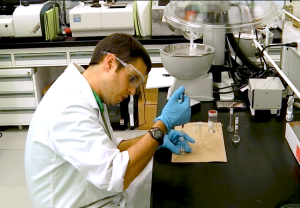
The long wait is over! A new publication is out, this one written by Martin Hollamby over the course of three tough years. For those who haven’t seen his one-minute intro video, Martin is investigating the behaviour of molecules in solvents. In his excellent paper, he shows how his range of molecules can self-assemble in (hydrophobic) solvents to form a variety of shapes and forms.
[ed: Martin talks about it in his own words here]
Martin has achieved this self-assembly in a variety of solvents such as n-alkanes. His molecules consist of two segments: a solvophilic part (“likes the solvent”) and a solvophobic part (“afraid of the solvent”). His first challenge was to prove that these molecules actually self-assemble in solution, something which was not self-evident. He uses a combination of many techniques to show that this is indeed the case, including UV/VIS absorption (spectrometry), SANS and SAXS, cryo-TEM, POM, viscosimetry and XRD.
Next, he had to show generality. He had to show that this behaviour can occur for a range of solvents, so he investigated the behaviour in toluene, chloroform and cyclohexane (no luck) and n-hexane, n-octane and n-decane (yes luck). Furthermore, he needed to adapt his molecule to show that it the same behaviour can also be achieved for modified variants thereof.

By playing around with the solvent, the molecules, the concentration and the temperature, he has shown he can thus form:
- core-shell particles (“micelles”)
- gel fibres from hexagonally ordered chains of these micelles
- lamellar mesophases
Some of these materials are optically active and others electronically active, so it may be possible to self-assemble electronic structures in liquids. This would add a whole new level of awesome to liquid chemistry.
My role in this research was rather small, and truth be told, Martin probably could have handled most of it himself as his scattering-fu is not bad at all. Nevertheless, I am very happy to have been able to help him with the SAS data corrections and some analysis, and I hope I can work more on this with him in the future.
To summarise, Martin appears to have opened a new field of study with his method and molecules. He is certainly one Brit to keep your eyes on!

Leave a Reply